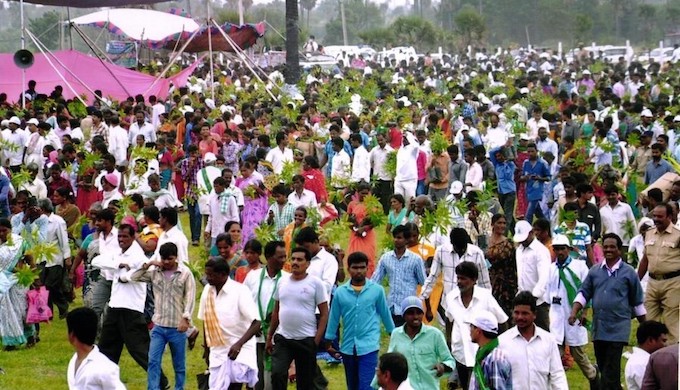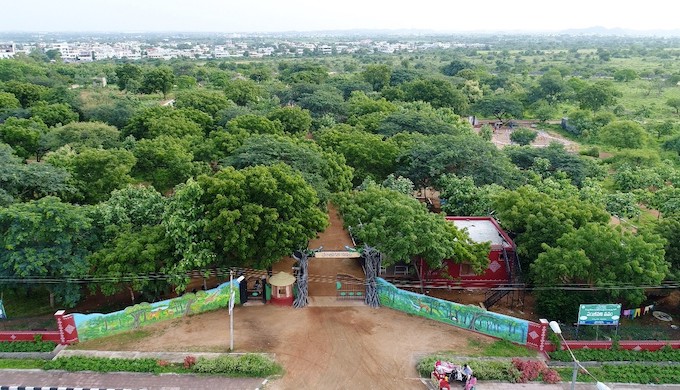The green garland scheme of Telangana is expected to raise forest cover in the southern Indian state to 33% of its total area to mitigate the impacts of greenhouse gas emissions

A large number of people in Telangana have been provided with seedlings under the Haritha Haram programme (Photo by Mohan Chandra Pargaien)
Forests support countless and diverse species, provide essential ecosystem services, stabilise climate, regulate the water regime, besides providing a direct source of livelihood for more than one billion people worldwide.
Having a two-fold role in climate change, forests can cause up to half of the global greenhouse emission due to land-use changes. At the same time, they are an excellent sink for carbon dioxide, the single biggest cause of global warming.
Having a huge potential to absorb about a sixth of global carbon emissions, forests across the globe provide one of the cheapest natural and low-tech ways to offset greenhouse gas emissions. When managed in a sustainable manner, reforestation and landscape restoration of forests help to reduce the vulnerability of both forest and forest-dependent communities to the consequences of climate change.
Since climate change is one of the major drivers of degradation of forests and disturbances to forest-dependent communities, environmentalists and foresters are now supporting the strategy of assisted natural regeneration also as an alternative to tree planting, which is low-cost, easy to adopt and a high-impact intervention to restore and rejuvenate degraded forests and biodiversity and sequester carbon as well.
Restoring 350 million hectares of degraded forests by 2030, which could sequester up to 1.7 gigatons of carbon dioxide equivalent annually, is the main objective of the Bonn Challenge, a land restoration and tree plantation programme initiated by the UN Convention to Combat Desertification.
Considering the many roles and services of trees, there had been initiatives at the international, national and local levels by increasing the tree cover and protecting and developing existing forest wealth, which are being subjected to many challenges by human activities.
Notable among these initiatives are the Trillion Trees initiative of the United Nations Environment Programme and Food and Agriculture Organisation, Plant a Billion Trees by non-profit Nature Conservatory and Billion Trees Tsunami of Pakistan.
In India, the federal government launched the Green India Mission (GIM) in 2014 to increase forest cover by five million hectares and to improve the quality of forest cover on another five million hectares of forest and non-forest lands.

A forested area in Hyderabad, the capital of Telangana (Photo by Mohan Chandra Pargaien)
As a signatory to the Paris climate pact, India has committed to creating an additional carbon sink of 2.5 to 3 billion tonnes of carbon dioxide equivalent through additional forest and tree cover by 2030. Various provincial governments have introduced tree-planting programmes such as Maharashtra’s plan of planting 330 million saplings and Uttar Pradesh’s plan of planting 220 million trees in 2019 and Madhya Pradesh planting 66 million trees in one day during 2017.
Green Garland
The recently created southern Indian province of Telangana launched its flagship greening intervention — Telangana Ku Haritha Haram (Green Garland for Telangana) — in 2015 to increase the green cover of the state from the existing 24% to 33%, with a target of planting one billion trees in existing forests and 1.3 billion outside forest lands.
Contrary to the conventional practice of entrusting the responsibility of tree planting to the forest department, other stakeholders have been included in this initiative. Frequent monitoring at various levels, active involvement of public representatives and implementation in various ingenious ways by field functionaries have resulted in the successful implementation of the programmes.
Linking tree planting programmes with wages and livelihood under various government schemes and incentives have resulted in wide acceptance and popularity of Haritha Haram.
This has helped not only to make all governmental organisations and other stakeholders responsible and empowered but also provided them with a good platform to address the challenges of climate change.
With the inclusive concept of Jungle Bachao, Jungle Badhao (Protect Forest, Expand Forest), the activities outside forest areas are centred on increasing greenery by way of planting in rural areas.
Considering the vital role of green cover in both cities and villages, the recent focus of the government has been to develop and create urban green spaces.
For the forest department, the mandate is like a dual platform, covering both protection and increase of forest growth, including restoration of degraded forests, which has been gaining much attention under the new approach of Forest Land restoration (FLR) to ensure sustainable land use for improving the wellbeing of humans and the environment.

A Red Sanders and Malabar Teak plantation in private land (Photo by Mohan Chandra Pargaien)
Since launching of the programme in 2015, so far 2.14 billion seedlings (1.42 billion outside forest areas and 0.72 billion inside forests) have been planted all over Telangana till October 2020 by involving citizens at all levels.
The programme has also been successful in restoring around 245,000 hectares of degraded forests by spending INR 50.8 billion (USD 0.69 billion) by various government departments.
Unique aspect
The unique aspect of the Haritha Haram programme is its landmark policy initiatives with priority to the environment as reflected in recently amended Panchayati Raj and municipal laws to include afforestation.
Coupled with institutional and financial support, these initiatives call for entrusting roles and responsibilities among panchayats (local self-governing bodies) and municipalities for planting and protection of trees, their survival (85%), and a generous allocation of funds.
Considering the efficacy and multifaceted utilities of forests, restoration of degraded and destroyed ecosystems has been identified as one of the proven measures to fight the climate crisis and enhance food security, water supply and biodiversity by the United Nations by declaring 2021–30 as the UN Decade on Ecosystem Restoration
Telangana’s Haritha Haram programme is in line with that initiative.
Mohan Chandra Pargaien is an Additional principal chief conservator of forests in Telangana.
As appeared in
https://indiaclimatedialogue.net/2020/12/14/telanganas-greening-overdrive-aims-at-mitigating-climate-change/












